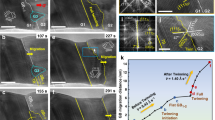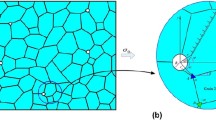Abstract
Experiments have revealed that stress-driven grain growth can strongly affect the movement and distribution of the dislocations in nanocrystalline materials. Meanwhile, nanotwinning often originates from the generation and glide of partial dislocations, which is also influenced by grain growth. However, the underlying effect of the grain growth on the nucleation of nanoscale twins remains unclear. In this work, a theoretical model is established to investigate the effect of cooperative grain growth by nanograin rotation and grain boundary migration on the nucleation of nanoscale twins in deformed nanocrystalline solids. The results indicate that, in most cases, the cooperative mechanism controls the nucleation of nanoscale twins. In particular, the cooperative mechanism significantly enhances the nanotwin nucleation outside the deformed grain, while inhibits that inside the deformed grain. The capacity of nanotwin nucleation can be significantly enhanced via decreasing the level of rotation or increasing the migration distance, and it can be maximized by tailoring the coupling factor of the migration process. Moreover, the nanotwin nucleation and its length can be simultaneously optimized via tailoring the cooperative grain growth. As a result, the cooperative grain growth can serve as an effective approach to enhance nanotwinning and thereby improve the plasticity of nanocrystalline materials.








Similar content being viewed by others
References
El-Atwani O, Esquivel E, Aydogan E et al (2019) Unprecedented irradiation resistance of nanocrystalline tungsten with equiaxed nanocrystalline grains to dislocation loop accumulation. Acta Mater 165:118–128
Li Y, Gao Y, Liu C et al (2018) Investigation on electrical transport properties of nanocrystalline WO3 under high pressure. J Mater Sci 53:6339–6349. https://doi.org/10.1007/s10853-018-2001-5
Liao X, Zhang J, Yu H et al (2019) Exceptional elevated temperature behavior of nanocrystalline stoichiometric Y2Fe14B alloys with La or Ce substitutions. J Mater Sci 54:14577–14587. https://doi.org/10.1007/s10853-019-03916-8
Zhou X, Li XY, Lu K (2018) Enhanced thermal stability of nanograined metals below a critical grain size. Science 360:526–530
Hu J, Shi YN, Sauvage X, Sha G, Lu K (2017) Grain boundary stability governs hardening and softening in extremely fine nanograined metals. Science 355:1292–1296
El-Atwani O, Hinks JA, Greaves G, Allain JP, Maloy SA (2017) Grain size threshold for enhanced irradiation resistance in nanocrystalline and ultrafine tungsten. Mater Res Lett 5:343–349
Mohr M, Daccache L, Horvat S, Brühne K, Jacob T, Fecht H Jr (2017) Influence of grain boundaries on elasticity and thermal conductivity of nanocrystalline diamond films. Acta Mater 122:92–98
Muche DNF, Drazin JW, Mardinly J, Dey S, Castro RHR (2017) Colossal grain boundary strengthening in ultrafine nanocrystalline oxides. Mater Lett 186:298–300
Zhang Y, Tucker GJ, Trelewicz JR (2017) Stress-assisted grain growth in nanocrystalline metals: grain boundary mediated mechanisms and stabilization through alloying. Acta Mater 131:39–47
Lu L (2004) Ultrahigh strength and high electrical conductivity in copper. Science 304:422–426
Ha S, Se-Jong K, Seunghee H et al (2010) Improvement of ductility in magnesium alloy sheet using laser scanning treatment. Mater Lett 64:425–427
Yang L, Tao NR, Lu K, Lu L (2013) Enhanced fatigue resistance of Cu with a gradient nanograined surface layer. Scr Mater 68:801–804
Li N, Shi S, Luo J, Lu J, Wang N (2016) Effects of surface nanocrystallization on the corrosion behaviors of 316L and alloy 690. Surf Coat Technol 309:227–231
Sihai L, Yinghong L, Liucheng Z et al (2016) Surface nanocrystallization of metallic alloys with different stacking fault energy induced by laser shock processing. Mater Des 104:320–326
Li N, Shi S, Luo J, Lu J, Wang N (2017) Effects of surface nanocrystallization on the corrosion behaviors of 316L and alloy 690. Surf Coat Technol 309:227–231
Li X, Lu K (2017) Playing with defects in metals. Nat Mater 16:700–701
Luo XM, Zhang B, Zhu XF, Zhou YT, Xiao TY, Zhang GP (2016) Local-structure-affected behavior during self-driven grain boundary migration. MRS Commun 6:85–91
Azizi A, Zou X, Ercius P et al (2014) Dislocation motion and grain boundary migration in two-dimensional tungsten disulphide. Nat Commun 5:4867–4873
Thomas SL, Chen K, Han J, Purohit PK, Srolovitz DJ (2017) Reconciling grain growth and shear-coupled grain boundary migration. Nat Commun 8:1764–1775
Li J, Soh AK, Wu X (2014) On nanograin rotation by dislocation climb in nanocrystalline materials. Scr Mater 78–79:5–8
Liu C, Lu W, Chen S, Li J (2019) Toughening of nanocrystalline materials by nanograin rotation. Mater Today Commun 19:297–299
Trautt ZT, Mishin Y, Actamat J (2003) Grain boundary migration and grain rotation studied by molecular dynamics. Acta Mater 51:2407–2424
Gorkaya T, Molodov KD, Molodov DA, Gottstein G (2011) Concurrent grain boundary motion and grain rotation under an applied stress. Acta Mater 59:5674–5680
Liu C, Lu W, Weng GJ, Li J (2019) A cooperative nano-grain rotation and grain-boundary migration mechanism for enhanced dislocation emission and tensile ductility in nanocrystalline materials. Mater Sci Eng, A 756:284–290
Yan FK, Tao NR, Archie F, Gutierrez-Urrutia I, Raabe D, Lu K (2014) Deformation mechanisms in an austenitic single-phase duplex microstructured steel with nanotwinned grains. Acta Mater 81:487–500
Zhu SQ, Yan HG, Liao XZ et al (2015) Mechanisms for enhanced plasticity in magnesium alloys. Acta Mater 82:344–355
Li Q, Xue S, Wang J et al (2018) High-strength nanotwinned Al alloys with 9R phase. Adv Mater 30:1704629
You Z, Li X, Gui L, Lu Q, Zhu T (2013) Plastic anisotropy and associated deformation mechanisms in nanotwinned metals. Acta Mater 61:217–227
Xu C, Yuan L, Shan D, Guo B (2019) The influence of lamellar twins on deformation mechanism in nanocrystalline magnesium under uniaxial compression. J Mater Sci 54:12623–12642. https://doi.org/10.1007/s10853-019-03803-2
Ostapovets A, Serra A (2017) Slip dislocation and twin nucleation mechanisms in hcp metals. J Mater Sci 52:533–540. https://doi.org/10.1007/s10853-016-0351-4
Luo X, Li X, Zhang G (2017) Forming incoherent twin boundaries: a new way for nanograin growth under cyclic loading. Mater Res Lett 5:95–101
Luo X, Zhu X, Zhang G (2014) Nanotwin-assisted grain growth in nanocrystalline gold films under cyclic loading. Nat Commun 5:3021–3028
Wang YQ, Smirani R, Ross GG (2004) Nanotwinning in silicon nanocrystals produced by ion implantation. Nano Lett 4:2041–2045
Wu XL, Zhu YT (2008) Inverse grain-size effect on twinning in nanocrystalline Ni. Phys Rev Lett 101:025503
Zhu YT, Liao XZ, Wu XL (2012) Deformation twinning in nanocrystalline materials. Prog Mater Sci 57:1–62
Ovid’ko IA, Skiba NV (2014) Generation of nanoscale deformation twins at locally distorted grain boundaries in nanomaterials. Int J Plast 62:50–71
Zhu YT, Wu XL, Liao XZ, Narayan J, Mathaudhu SN, Kecskes LJ (2009) Twinning partial multiplication at grain boundary in nanocrystalline fcc metals. Appl Phys Lett 95:031909
Zhu YT, Liao XZ, Wu XL (2008) Deformation twinning in bulk nanocrystalline metals: experimental observations. JOM 60:60–64
Zhu YT, Narayan J, Hirth JP, Mahajan S, Wu XL, Liao XZ (2009) Formation of single and multiple deformation twins in nanocrystalline fcc metals. Acta Mater 57:3763–3770
Sansoz F, Dupont V (2006) Grain growth behavior at absolute zero during nanocrystalline metal indentation. Appl Phys Lett 89:111901
Cahn JW, Yuri M, Akira S (2006) Coupling grain boundary motion to shear deformation. Acta Mater 54:4953–4975
Romanov AE, Anna LK (2009) Application of disclination concept to solid structures. Prog Mater Sci 54:740–769
Gutkin MY, Ovid’ko IA, Skiba NV (2008) Crack-stimulated generation of deformation twins in nanocrystalline metals and ceramics. Philos Mag 88:1137–1151
Hirth JP, Lothe J (1982) Theory of dislocations (2nd ed). Wiley, New York
Kibey S, Liu JB, Johnson DD, Sehitoglu H (2007) Predicting twinning stress in fcc metals: linking twin-energy pathways to twin nucleation. Acta Mater 55:6843–6851
Bozzolo N, Soua N, Logé RE (2012) Evolution of microstructure and twin density during thermomechanical processing in a γ-γ’ nickel-based superalloy. Acta Mater 60:5056–5066
Gutkin MY, Ovid’ko IA, Skiba NV (2006) Generation of deformation twins in nanocrystalline metals: theoretical model. Phys Rev B 74:172107
Li Q, Cahoon JR, Richards NL (2009) Effects of thermo-mechanical processing parameters on the special boundary configurations of commercially pure nickel. Mater Sci Eng, A 527:263–271
Acknowledgements
The authors would like to deeply appreciate the support from the National Natural Science Foundation of China (11572118, 11602080 and 11772122), Hunan Provincial Natural Science Foundation of China (2018JJ3026) and the Fundamental Research Funds for the Central Universities.
Author information
Authors and Affiliations
Corresponding author
Additional information
Publisher's Note
Springer Nature remains neutral with regard to jurisdictional claims in published maps and institutional affiliations.
Rights and permissions
About this article
Cite this article
Tan, F., Fang, Q., Li, J. et al. Enhanced nanotwinning by special grain growth in nanocrystalline materials. J Mater Sci 55, 3618–3628 (2020). https://doi.org/10.1007/s10853-019-04194-0
Received:
Accepted:
Published:
Issue Date:
DOI: https://doi.org/10.1007/s10853-019-04194-0




